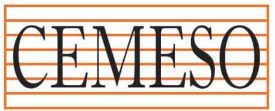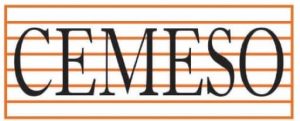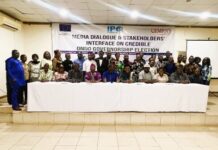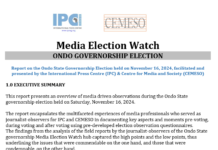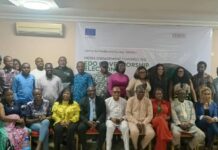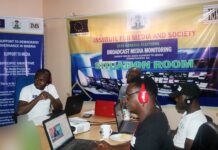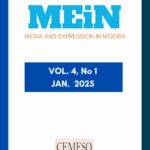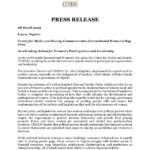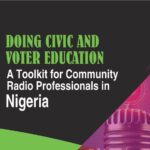The Executive Director,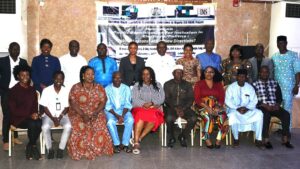 Institute for Media and Society, IMS, Dr. Akin Akingbulu opened the activity with an opening remark. He said IMS implements the Support to Media component of the European Union Support to Democratic Governance in Nigeria, EU-SDGN project.
Institute for Media and Society, IMS, Dr. Akin Akingbulu opened the activity with an opening remark. He said IMS implements the Support to Media component of the European Union Support to Democratic Governance in Nigeria, EU-SDGN project.
 Institute for Media and Society, IMS, Dr. Akin Akingbulu opened the activity with an opening remark. He said IMS implements the Support to Media component of the European Union Support to Democratic Governance in Nigeria, EU-SDGN project.
Institute for Media and Society, IMS, Dr. Akin Akingbulu opened the activity with an opening remark. He said IMS implements the Support to Media component of the European Union Support to Democratic Governance in Nigeria, EU-SDGN project.Dr Akingbulu further stated IMS implements activities based on the overall and specific objectives of the retreat was to improve media engagement in promoting women, youth and People with Disabilities in the electoral and political process.
He explained the need for the retreat and the roles of Institute for Media and Society, IMS, which includes strengthening media engagement in promoting inclusion, building professionalism, content production between various media organisations, and public sensitization.
The retreat was to analyse and evaluate the execution of the program, “Inclusion 4 Democracy”, a public sensitization programme on selected radio and television stations across the country recently concluded. This was to look at what worked, what did not work, what can be done in the future.
It was noted that the media did not give full attention to people living with disability, 5% coverage to PWDs, 29% to women, 46% for youths and the content is more on the negative side and to a large extent skewed.
At the end of the two-day retreat there were some recommendations
Stations’ Collaboration and Sustainability for Inclusion of PWDs, Women and Youths.
There’s a deliberate need for each station across the country to have already existing programmes tailored towards these marginalised groups with the aim of amplifying their voices and pushing towards a common goal which is their Inclusion in electioneering process and leadership.
A support team to be established for each of these demographics sourcing members of these teams from each of the groups from Researchers, programmes manager, Production and even the anchor persons while involving those at the grass root. Coming up with topics for a long term to aid consistency. This should be done quarterly with at least 3 episodes covering the demographics.
Using Social media as a tool with hashtags to drive home this course and get the conversation running and also as feedback mechanism to do and be better with our approach. We also talked about exploring the PWDs existing law and how the
percentage required for employment can be implemented while working closely with the
different Association these demographics belong to.
Partner with Development partners, NGOs, donors, faith based organisations through proposals. Have workshops and orientation programs especially those at the grassroots.
More Co-production amongst stations. The need to have cultural exchange amongst different tribes so non is left feeling marginalised because of language barrier. Sharing of recorded programs while putting competition aside and working towards a common goal for these demographics.
There is need to work together for positive impact in the society, as regards inclusiveness of women, youths and People with disabilities in electoral and democratic process.
Collaboration is all about working together for a singular purpose and eliminate competition but see each other as partners to development.
Communication, Punctuality and dedication are essential and key elements to collaboration.
Ideas are shared: on News Report, programming, news gathering, etc.
Also, to make it sustainable, there should be Team work, Program Ideation and formats, then Create a platform for engagement, eg, WhatsApp Groups.
Other approaches can be applied like Strategies for community engagement and participation using the approach of Theater for Development. Drama, Town Hall meeting formats, Leverage on different platforms for communicate: podcast, new media: Twitter etc
Furthermore, identify the important clusters with the communities; Okada Riders, Landlord Association, etc
Contiguous stations can work on the same program idea, share the logistics and decide on when to air it as a form of syndication.
There could be Challenges like, logistics and funding
Resentment and competitive ideas
Get the interest of the influencers, stakeholders, get their buy-in, what’s in it for the station
Inclusion for Democracy Programming: What Pathway to Sustainability on Stations Across the Country.
Create a handshake across the country.
Understand that we are not in competition but collaboration.
PEER Review method
Sharing: Robust cross-pollination of ideas
Maintain strong contact with each other on various projects.
Work on special reports on various challenges confronting the people.
Monitoring and Evaluation process jointly owned and executed
Collaborative efforts through targeted programs for women, youth and PWDs.
This can be done through existing programs which takes away the issue of financing.
Leveraging on technology.
This can be done through the use of social media; Twitter, WhatsApp, Zoom and others. Live transmission and live streaming can also be used.
Simultaneous programming on inclusion.
Two stations coming together to have same program, with the same hashtag on social media. The programs may be aired at the same time on the two stations that are collaborating.
The use of podcast.
Recording a podcast session which can be aire don both stations collaborating together.
Choosing a commonly acceptable language. Stations collaborating can come up with an acceptable language common to the people where each of the stations are situated. It could be pidgin or Hausa if the station is Kano or otherwise.
Sharing newsrooms
Producers and backroom staff of stations collaborating could have editorial meetings at either of the stations.
Sourcing for guests
Producers collaborating can take turns to source for guests in line with the topics being treated.
